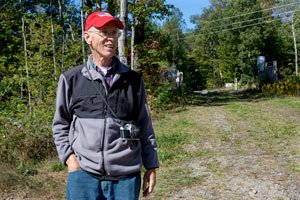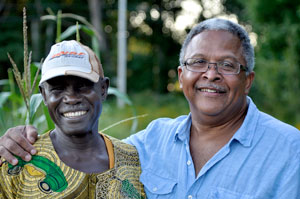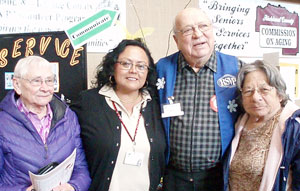Nov 18, 2014
Volunteering A Win-Win for Seniors and Rural Communities
by Candi Helseth

As part of Maine's ENCorps senior volunteer program, Don Nodine volunteers about 400 hours each year, maintaining 20 miles of free trails used by cross-country skiers during Maine's winters. Edgar Anderson works side-by-side with African refugees in the state, helping them plant and grow gardens, raising produce to feed their families and to donate to local food banks.
“Older volunteers experience better emotional health because of the social connections volunteering gives them,” ENCorps Program Manager Jennifer Crittenden said. “They also are learning something new, which is important for aging and maintaining cognitive health.”
On a national scale, the National Senior Corps Association (Senior Corps) unifies seniors interested in volunteering through any of three organizations under the NSCA umbrella: Foster Grandparents, RSVP (Retired and Senior Volunteer Program) and Senior Companions. About 337,000 American seniors in all 50 states volunteer in Senior Corps programs.
“In rural communities, the service of older adults can be of crucial value for the nonprofit organizations serving the population, helping to expand the capacity or extend services to more individuals,” said Wendy Spencer, CEO of the Corporation for National and Community Service (CNCS), the federal agency that operates the Senior Corps program.
Personalizing Volunteerism
ENCorps (Encore Leadership Corps), a program of the University of Maine Center on Aging in partnership with the Maine Community Foundation, is open to seniors 50 and over who are interested in maximizing volunteer participation in their communities. ENCorps provides services for volunteers such as skill-building training, educational workshops, networking and modest financial support.

The beauty of ENCorps, Crittenden said, is that it allows volunteers to choose particular projects of interest in their communities. Nodine, an enthusiastic outdoorsman who cross-country skis, applied for an ENCorps stipend to repair the lot where skiers park near the trails. Anderson anticipates building a greenhouse to better serve Maine's large African refugee population. The university's Tidewater Farms provides a support network for this population, which is struggling with a traumatic past and separation from family.
“We can fit ENCorps locally to our needs rather than the needs being identified by federal and state level entities,” Crittenden explained. “Senior Corps is a national model that focuses on key areas for volunteer placement. It's a great model for people interested in volunteering and looking for a good fit.”
Maine has many strong Senior Corps volunteers too. In 2013, Foster Grandparents met the needs of 2,258 children with special needs. RSVP volunteers provided 12,607 hours of Medicare counseling and delivered 164,785 meals through Meals on Wheels. Senior Companions made 27,780 home visits to 850 clients.
Currently, 16 percent of Maine residents are over 65, compared to 13 percent nationally. By 2020, one in five will be over 65, Crittenden said. Sixty-three percent live in rural communities.
Enhancing Community Outreach
In Montana, approximately 200 RSVP volunteers assist with activities coordinated by more than 25 nonprofit organizations in Richland County, where just under 10,000 residents are spread throughout 2,100 square miles. Long distances separate medical services. Home care services are spotty and public transportation limited.
“Senior volunteers are important in helping our community maintain services because, without them, many things would not be accomplished and many of these services would not exist,” said Greta Mannen, RSVP Director for Richland County. “Many of these organizations are nonprofit businesses operating with tight budgets and staffing shortages.”

RSVP's Seniors Outreaching To Seniors (SOS) fills a gap for residents there who would be unable to continue living independently without some in home assistance. RSVP also works closely with The Senior Coalition, a community organization that addresses senior issues, such as medication setups and funding assistance.
As a family member, Theresa Livers appreciated Senior Companions' benefits when her father was admitted to a nursing home. Livers' 90-year-old mother remained in their home.
“Senior Companions became an extremely valuable part of my mother's last years because all her friends were gone, so she welcomed these new friends and their visits,” Livers said. “It gave her something uplifting in her day to focus on. The Senior Companion program strives to improve the quality of life for seniors, making the most of what time is left while much of society just focuses on quantity of life.”
Livers, who is Continuum of Care Administrator at Sidney Health Center, said social workers often refer hospitalized patients to Senior Companions at the time of discharge. The social support helps ensure that these patients continue to recuperate and achieve the best possible level of health and well-being.
“RSVP and Senior Companions are a major support not only for our organization, but for the entire community,” Livers said. “We can certainly attest to their great work and the need for these programs.”
More than 6,600 Montana residents volunteer through Senior Corps programs. In addition to more than 820 nonprofit organizations benefiting from RSVP volunteers, Montana RSVP volunteers are also involved in projects such as safety patrols, home renovations, youth mentoring and responding to natural disasters. In 2013-2014, Senior Companions assisted with more than 1,000 homebound seniors. Foster Grandparents mentored more than 5,300 special needs young people.
“Our volunteers have varied interests and passions,” Mannen said. “We place them in a volunteer site that they enjoy.”
Building Senior Volunteerism
As Baby Boomers—76 million Americans born between 1946 and 1964—continue to reach the age typically associated with retirement, the pool of potential senior volunteers will keep increasing. Based on U.S. Census data, the number of volunteers age 65 and over is likely to increase 50 percent over the next 13 years.
The influence of Baby Boomers on the volunteer market is already visible. Baby Boomers now in their mid- to late-50s have higher volunteer rates than past generations at those ages. They have relatively higher education levels, skills and experience. However, Baby Boomers also have different expectations for volunteering than previous generations, according to Keeping Baby Boomers Volunteering.
“When we compare our RSVP and ENCorps members, ENCorps members tend to be younger,” Crittenden said. “The ENCorps model is particularly attractive to Baby Boomers because many are still in the workforce. They have particular skills they want to use. We've even seen them launch new careers from their volunteer work.”
ENCorps' structural approach also appeals to Baby Boomers, she added. Electronic communication, webinars and other technologies are used for education, training and support.
“For the most part, we engage with them online,” Crittenden said. “And the way we set up the program with flexibility makes it more attractive to the Baby Boomer population.”
A rural volunteerism study done by the Minnesota Association for Volunteer Administration cites flexibility, short-term projects, community connections, transportation assistance and placement of volunteers in rewarding situations as important strategies to engage rural volunteers.
Educating rural residents about volunteerism's health benefits can also be advantageous. Those who volunteer have lower mortality rates, greater functional ability and lower rates of depression later in life than those who do not volunteer, according to The Health Benefits of Volunteering.
Last year, 64.5 million Americans volunteered nearly $7.9 billion in hours. Volunteers age 65 and over spent a median of 90 hours on volunteer activities, the highest among any age group and well above the 50 median hours donated by the general volunteer population. These volunteers extend the capabilities of national and local nonprofits, schools, disaster relief groups, public agencies and faith-based and community organizations, according to CNCS's Impact on Our Nation.
“With a lifetime of skills and experience, Baby Boomers and senior volunteers are uniquely suited to serve the needs of our children, veterans and elderly,” Spencer affirmed.
However, the greatest benefit may be for the volunteers themselves. “We see every day how true it is that volunteering keeps people young at heart,” Crittenden said.
Back to: Fall 2014 Issue
